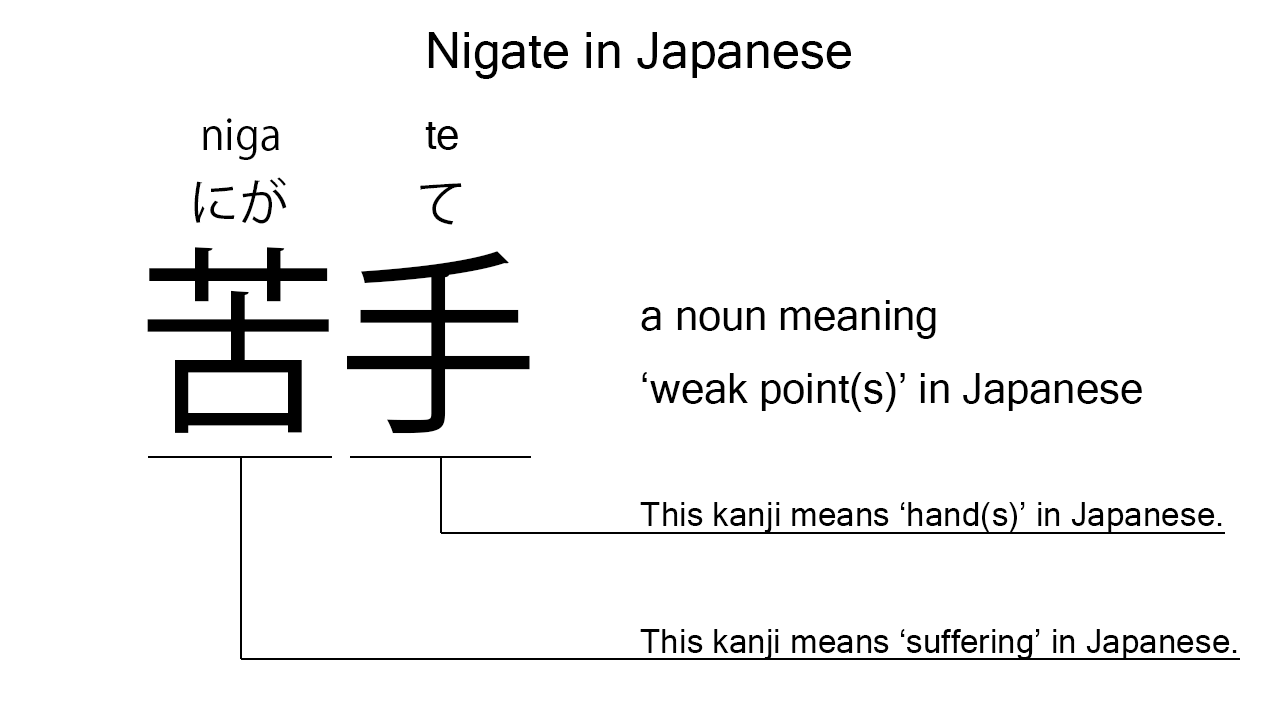What does “nigate” mean in Japanese?
Native speakers say “nigate” often to mean ‘weak point’ in Japanese. Perhaps, some Japanese learners know this word as it is sometimes used in Japanese textbooks. In this blog post, however, I will explain this word in detail based on its kanji expression. And also, I will explain how to use it through example sentences. My explanations would help Japanese learners understand “nigate” more clearly. Then, let’s get started!
Contents
Definition and meanings of “nigate”
Let me start with the definition and meanings of “nigate”.
- nigate – 苦手 (にがて) : a noun meaning ‘weak point’ in Japanese. This can also work as plural. Learn more about Japanese plural. This can also be used like an adjective to mean ‘not good (at something)’, ‘bad (at something)’, or such in Japanese.
In Japanese, the border between nouns and some adjectives called na-adjectives is very ambiguous. Many na-adjectives consist of a noun and a conjugative suffix, but native speakers quite often omit the suffix especially in speaking. Many Japanese nouns, therefore, can be the shortened versions of the corresponding na-adjectives. “Nigate” is one of them. It can work as the shortened version of “nigatena” which is a na-adjective meaning ‘not good (at something)’, ‘bad (at something)’, or such in Japanese.
I’ve explained the very basics of “nigate”. To understand this word more clearly, however, let me explain its kanji characters in detail, one by one.
Nigate in kanji
The kanji expression of “nigate” consists of the following two kanji characters:
- 苦 : a kanji character used to mean ‘pain’, ‘suffering’, ‘trouble’, ‘anxiety’, or ‘difficulty’ in Japanese. This can also be found in other words like “nigai“.
- 手 : a kanji character widely used to mean ‘hand’ in Japanese.
These two kanji characters tell us that “nigate” can mean ‘suffering from doing something with hands’ in Japanese. This interpretation is not in line with the actual meanings, but still understandable, I think. Weak points are often something we cannot overcome without suffering.

When we meet new kanji expressions, we should check their kanji characters in detail to understand their meanings clearly and deeply. In many cases, kanji characters tell us a lot about the meanings of the expressions they form. Actually, here, we could get the better understanding of “nigate” through the detailed kanji check above.
So far, I’ve explained the definition and meanings of “nigate” together with its kanji characters. Then, let me explain how to use it through the example sentences below.
Example #1: how to say “weak point” in Japanese
watashi wa nigate wo kokufuku shi ta – 私は苦手を克服した (わたしはにがてをこくふくした)
I overcame my weak point.
Below are the new words used in the example sentence.
- watashi – 私 (わたし) : a pronoun meaning ‘I’ in Japanese.
- wa – は : a binding particle working as a case marker or topic marker. In the example, this works after “watashi” to make the subject in the sentence.
- wo – を : a case particle used to make the object word in a sentence. In the example, this is used after “nigate” to make the object in the sentence.
- kokufuku shi – 克服し (こくふくし) : one conjugation of the verb, “kokufuku suru”, which means ‘to overcome’ in Japanese. In the example, it has been conjugated for the better connection with its following word.
- ta – た : an auxiliary verb used after a verb, adjective, or auxiliary verb to make its past tense form. Probably, this is well known as a part of Japanese ta form. In the example, this is used after “kokufuku shi” to make its past tense form.
This is a typical usage of “nigate”. In this example, it works together with the case particle, “wo”, to become the object in the sentence.
Example #2: another usage of “nigate”
boku wa nihongo ga nigate desu – 僕は日本語が苦手です (ぼくはにほんごがにがてです)
I’m bad at Japanese.
Below are the new words used in the example sentence.
- boku – 僕 (ぼく) : a pronoun meaning ‘I’ in Japanese. This is used mainly by boys and young males.
- nihongo – 日本語 (にほんご) : a noun meaning ‘Japanese’ or ‘the Japanese language’ in Japanese.
- ga – が : a case particle used to make the subject word or the object word in a sentence. In the example, this is used after “nihongo” to make the object in the sentence.
- desu – です : an auxiliary verb used after a noun or adjective to make it polite. Probably, this is well known as a part of Japanese desu form. In the example, this is used after “nigate” to make it sound polite.
This is another typical usage of “nigate”. In this example, it works like an adjective to mean ‘bad at’ in Japanese. When we want to say ‘bad (at something)’ in Japanese, this word is a good option.
Summary
In this blog post, I’ve explained the definition and meanings of “nigate” in detail based on its kanji expression. And also, I’ve explained how to use it through the example sentences. Let me summarize them as follows.
- nigate – 苦手 (にがて) : a noun meaning ‘weak point’ in Japanese. This can also work as plural. This can also be used like an adjective to mean ‘not good (at something)’, ‘bad (at something)’, or such in Japanese. These two kanji characters mean ‘suffering from doing something with hands’ in Japanese. This interpretation is not in line with the actual meanings, but still understandable, I think. Weak points are often something we cannot overcome without suffering.
Hope my explanations are understandable and helpful for Japanese learners.